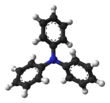| |||
| Names | |||
|---|---|---|---|
| Preferred IUPAC name
N,N-Diphenylaniline | |||
| Other names
Triphenylamine
N,N,N-Triphenylamine N,N-Diphenylbenzeneamine | |||
| Identifiers | |||
3D model (JSmol)
|
|||
| ChemSpider | |||
| ECHA InfoCard | 100.009.123 | ||
| EC Number |
| ||
PubChem CID
|
|||
| RTECS number |
| ||
| UNII | |||
CompTox Dashboard (EPA)
|
|||
| |||
| |||
| Properties | |||
| C18H15N | |||
| Molar mass | 245.325 g·mol−1 | ||
| Appearance | Off-white solid | ||
| Density | 0.774 g/cm3 | ||
| Melting point | 127 °C (261 °F; 400 K) | ||
| Boiling point | 347 to 348 °C (657 to 658 °F; 620 to 621 K) | ||
| Almost insoluble | |||
| log P | 5.74 | ||
| Hazards | |||
| GHS labelling: | |||

| |||
| Warning | |||
| H315, H319 | |||
| P264, P280, P302+P352, P305+P351+P338, P321, P332+P313, P337+P313, P362 | |||
| Flash point | 180 °C (356 °F; 453 K) open cup | ||
| NIOSH (US health exposure limits): | |||
PEL (Permissible)
|
none[1] | ||
REL (Recommended)
|
TWA 5 mg/m3[1] | ||
IDLH (Immediate danger)
|
N.D.[1] | ||
Except where otherwise noted, data are given for materials in their standard state (at 25 °C [77 °F], 100 kPa).
| |||
Triphenylamine is an organic compound with formula (C6H5)3N. In contrast to most amines, triphenylamine is nonbasic. At room temperature it appears as a colorless crystalline solid, with monoclinic structure. It is well miscible in diethyl ether and benzene, but it is practically insoluble in water, and partially in ethanol. Its derivatives have useful properties in electrical conductivity and electroluminescence, and they are used in OLEDs as hole-transporters.[2]
Triphenylamine can be prepared by arylation of diphenylamine.[3]
- ^ a b c NIOSH Pocket Guide to Chemical Hazards. "#0643". National Institute for Occupational Safety and Health (NIOSH).
- ^ Wei Shi, Suqin Fan, Fei Huang, Wei Yang, Ransheng Liu and Yong Cao "Synthesis of Novel Triphenylamine-based Conjugated Polyelectrolytes and Their Application to Hole-Transport Layer in Polymeric Light-Emitting Diodes" J. Mater. Chem., 2006, 16, 2387-2394. doi:10.1039/B603704F
- ^ F. D. Hager "Triphenylamine" Org. Synth. 1928, 8, 116. doi:10.15227/orgsyn.008.0116

